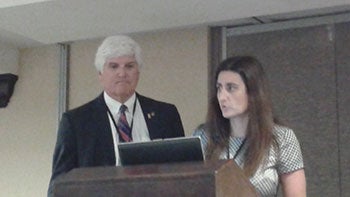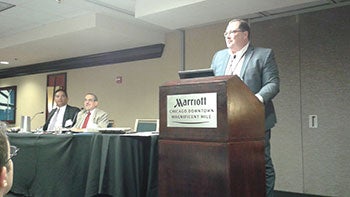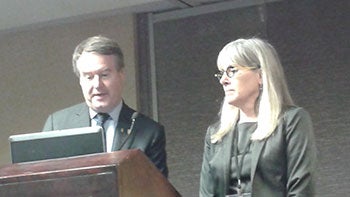Architects explore innovation at annual summit
 |
| Anthony Haas, president of the American College of Healthcare Architects, and Tatiana Guimaraes, president of the American Institute of Architects/Academy of Architecture for Health, address the groups’ 2015 Summer Leadership Summit in Chicago. |
As hospitals and health systems look to innovative solutions to bridge the gap between reduced reimbursements and increased demands, it’s not surprising that almost 200 of the nation’s leading health care architects and designers adopted innovation as the theme of their high-level conference in Chicago last weekend.
The 2015 Summer Leadership Summit, presented by the American College of Healthcare Architects (ACHA) and the American Institute of Architects/Academy of Architecture for Health (AIA/AAH), explored “The Role of Innovation in Healthcare” as it relates to care delivery, technology adoption and, of course, health care design.
Prior to the summit was a luncheon for ACHA-certified architects that featured Barbara Spurrier, administrative director of the Mayo Clinic’s Center for Innovation, who spoke on “transforming the experience and delivery of health care.” Immediately afterward, the summit itself featured more presentations by innovation leaders from Kaiser Permanente, Cleveland Clinic, Mosaic Life Care as well as the Innovation Institute for-profit organization of nonprofit health systems.
 |
| From left: Speaking on the value of the Baldrige quality system for driving innovation are Michael Pulido, chief administrative officer with Mosaic Life Care; Harry Hertz, director emeritus of the Baldrige Performance Excellence Program for the National Institute of Standards and Technology; and Mark Erath, an independent performance excellence consultant. |
“Innovation is a huge buzzword right now,” said Larry Stofko, executive vice president of the Innovation Institute during a session on “innovation and collaboration in health care.” “There are groups that are pulling together departments, they’re hiring chief innovation officers and joining innovation organizations.”
Breaking provider-based innovation models into four types, Stofko identified an “outside-in” model, in which organizations look for innovations on the outside that they can bring in and deploy; an “inside-out” model, in which organizations work with employees and physicians who have ideas to develop and market them; a traditional tech-transfer model that comes from research that is published to the outside world; and a venture-fund model, in which the organization takes an equity stake in a company that can help it solve problems.
Regarding designs that help to foster innovation, Stofko advised architects to make spaces flexible, inspiring, collaborative and social. He also said designers should make spaces “a hard-working tool” that reflects the organization’s culture and brand.
Moving further into the design area, another session explored how innovation is accommodated by the Facility Guidelines Institute’s (FGI’s) series of design and construction guidelines.
 |
| Closing out the 2015 Summer Leadership Summit were Mark Nichols, president-elect the American College of Healthcare Architects, and Joan Suchomel, president-elect of the American Institute of Architects/Academy of Architecture for Health. |
Encouraging innovation is a big part of FGI’s efforts, said Kurt Rockstroh, president and CEO of Steffian Bradley Architects and Sterling Planning Alliance, who serves as president of the FGI. “We do not want the guidelines in any way, shape or form to get in the way of innovation.”
Other sessions at the summit focused on discussions of innovative technologies, including medical simulation models and 3-D printing applications for health care, as well as a presentation on how the Baldrige quality system can be used to spur innovation.
Also during the summit:
• The AAH presented the 2015 AAH Design Awards.
• The AAH Foundation announced the initiation of a Legacy Fund campaign to allow contributors to support educational and research initiatives through phased, deferred or estate programs.
• The AAH named recipients of its AAH U40 (under 40) list: Brandy Olson of HDR in Omaha, Neb., and Erin Peavey of HOK in New York City.
• The AAH and ACHA introduced the 2015 Summer Leadership Summit Next Generation Scholars: Kerianne Graham of NBBJ in Boston, and Luiz Martinez of Innova Group in Austin, Texas.




